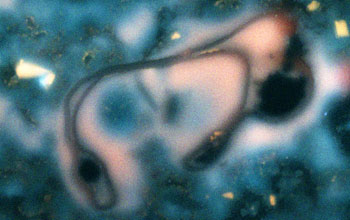Multimedia Gallery
Cathodoluminescent image of sedimentary rock with tiny quartz crystals
A cathodoluminescence image from a ~370 million-year-old sedimentary rock (Devonian New Albany Shale from Indiana) consisting largely of tiny quartz crystals that grew early in sediment history, probably within 20 to 50 centimenters of burial below the seafloor.
More about this Image
Typically, quartz that grows under such low temperature conditions shows none or only minimal CL. In this picture, such quartz is represented by areas with a bluish hue (high contrast exposure). There are also however, areas where the quartz luminesces with a pinkish-red color, even though all of the quartz in the sample formed at the same time. These pinkish-red areas are all adjacent to a dark line that winds through the central portion of the image, representing the organic wall of an algal cyst. The likely reason for the pinkish-red colors associated with this cyst is a mass of bacterial slime that initially surrounded the cyst during decay processes, and produced conditions for quartz pecipitation that differed from those further away.
Many minerals emit visible light (they luminesce) when they are bombarded with electrons. The light is produced at crystal defects and by impurities (foreign atoms) within the crystals. The wave-length (or color) of the emitted light is therefore related to the growth conditions of the mineral. The phenomenon of light emission by electron bombardment is commonly known as cathodoluminescence, or CL.
This photo was taken with an electron microscope where an electron beam scans over the surface of the sample and, one spot at a time, excites CL that is recorded by a special color-sensitive detector (GATAN Chroma-CL).
This image is part of research supported by National Science Foundation grant EAR 0318769, awarded to Juergen Schieber, Department of Geological Sciences, Indiana University. (Date of Image: Aug. 17, 2005)
Credit: Image by Juergen Schieber, Department of Geological Sciences, Indiana University. Instrumentation: SEM FEI Quanta-FEG 400 with Gatan Chroma CL.
Images and other media in the National Science Foundation Multimedia Gallery are available for use in print and electronic material by NSF employees, members of the media, university staff, teachers and the general public. All media in the gallery are intended for personal, educational and nonprofit/non-commercial use only.
Images credited to the National Science Foundation, a federal agency, are in the public domain. The images were created by employees of the United States Government as part of their official duties or prepared by contractors as "works for hire" for NSF. You may freely use NSF-credited images and, at your discretion, credit NSF with a "Courtesy: National Science Foundation" notation.
Additional information about general usage can be found in Conditions.
Also Available:
Download the high-resolution TIF version of the image. (12.0 MB)
Use your mouse to right-click (Mac users may need to Ctrl-click) the link above and choose the option that will save the file or target to your computer.

 All images in this series
All images in this series